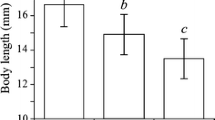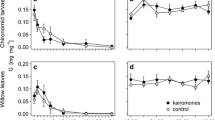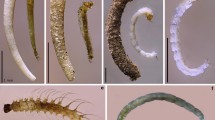Abstract
In most European freshwater ecosystems, the invasive gammarids Gammarus tigrinus and Dikerogammarus villosus strongly impair recipient communities through predation of a wide range of native invertebrates. Due to the effects of temperature on both the physiology and the behaviour of such ectotherms, understanding how global warming may influence their ecological impact is a research priority. These species were therefore exposed to three different food types to determine their detritivorous, herbivorous and carnivorous characters, and predation was measured characterizing the Holling’s functional response. The effect of increasing water temperatures (15, 20, 25°C) on both the food choice and predatory activities was investigated. Both species showed a significant preference for animal tissues at all temperatures. The total food intake increased with temperature for G. tigrinus but did not change for D. villosus, which may result from specific species differences in metabolic requirements. The consumption of live prey strongly increased with temperature. The main differences were an increased searching efficiency in G. tigrinus and a decreased handling time in D. villosus as temperature increased, which may result from differences in foraging strategies. These results suggest that climate change is likely to increase the predation pressure of both invasive gammarids on prey species.





Similar content being viewed by others
References
Beale, E. M. L., 1960. Confidence regions in non-linear estimation (with discussion). Journal of the Royal Statistical Society 22: 41–88.
Bellard, C., W. Thuiller, B. Leroy, P. Genovesi, M. Bakkenes & F. Courchamp, 2013. Will climate change promote future invasions? Global Change Biology 19: 3740–3748.
Bollache, L., S. Devin, R. Wattier, M. Chovet, J. N. Beisel, J. C. Moreteau & T. Rigaud, 2004. Rapid range extension of the Ponto–Caspian amphipod Dikerogammarus villosus in France: potential consequences. Archiv für Hydrobiologie 160: 57–66.
Bollache, L., J. T. A. Dick, D. K. Farnsworth & I. W. Montgomery, 2008. Comparison of the functional responses of invasive and native amphipods. Biology Letters 4: 166–169.
Colinet, H. B., J. Sinclair, P. Vernon & D. Renault, 2015. Insects in fluctuating thermal environments. Annual Review of Entomology 60: 7.1–7.18.
Dehedin, A., C. Maazouzi, S. Puijalon, P. Marmonier & C. Piscart, 2013. Combined effects of the water level reduction and the increase in ammonia concentrations on organic matter processing by key freshwater shredders in alluvial wetlands. Global Change Biology 19: 763–774.
Díaz Villanueva, V., R. Albariño & C. Canhoto, 2011a. Detritivores feeding on poor quality food are more sensitive to increased temperatures. Hydrobiologia 678: 155–165.
Díaz Villanueva, V., J. Font, T. Schwartz & A. M. Romaní, 2011b. Biofilm formation at warming temperature: acceleration of microbial colonization and microbial interactive effects. Biofouling 27: 59–71.
Dick, J. T. A. & D. Platvoet, 1996. Intraguild predation and species exclusions in amphipods: the interaction of behaviour, physiology and environment. Freshwater Biology 36: 375–383.
Dick, J. T. A. & D. Platvoet, 2000. Invading predatory crustacean Dikerogammarus villosus eliminates both native and exotic species. Proceedings of the Royal Society of London B 267: 977–983.
Dick, J. T. A., D. Platvoet & D. W. Kelly, 2002. Predatory impact of the freshwater invader Dikerogammarus villosus (Crustacea: Amphipoda). Canadian Journal of Fisheries and Aquatic Sciences 59: 1078–1084.
Dick, J. T. A., M. Armstrong, H. C. Clarke, K. D. Farnsworth, M. J. Hatcher & M. Ennis, 2010. Parasitism may enhance rather than reduce the predatory impact of an invader. Biology Letters 6: 636–638.
Dick, J. T. A., K. Gallagher, S. Avlijas, H. C. Clarke, S. E. Lewis, S. Leung & A. Ricciardi, 2013. Ecological impacts of an invasive predator explained and predicted by comparative functional responses. Biological Invasions 15: 837–846.
D.R.E.A.L. Bretagne, 2014. Direction Régionale de l’Environnement, de l’Aménagement et du Logement. http://www.bretagne.developpement-durable.gouv.fr/eau.
Foucreau, N., C. Piscart, S. Puijalon & F. Hervant, 2013. Effect of climate-related change in vegetation on leaf litter consumption and energy storage by Gammarus pulex from continental or mediterranean populations. PloS one 8: e77242.
Foucreau, N., D. Cottin, C. Piscart & F. Hervant, 2014. Physiological and metabolic responses to rising temperature in Gammarus pulex populations (Crustacea) living under continental or mediterranean climates. Comparative Biochemistry and Physiology (A) 168: 69–75.
Gerritsen, J., 1982. Behavioral response of daphnia to rate of temperature change: possible enhancement of vertical migration. Limnology and Oceanography 27: 254–261.
Holling, C. S., 1959a. The components of predation as revealed by a study of small-mammal predation of the European pine sawfly. The Canadian Entomologist 91: 293–320.
Holling, C. S., 1959b. Some characteristics of simple types of predation and parasitism. The Canadian Entomologist 91: 385–398.
IPCC, 2013. Summary for policymakers. The physical science basis. Contribution of working group I to the 5th assessment report of the intergovernmental panel on climate change. In: Stocker, T. F., D. Qin, G. K. Plattner, M. Tignor, S. K. Allen, J. Boschung, A. Nauels, Y. Xia, V. Bex & P. M. Midgley (eds), Climate Change 2013. Cambridge University Press, Cambridge, United Kingdom and New York.
Issartel, J., F. Hervant, Y. Voituron, D. Renault & P. Vernon, 2005a. Behavioural, ventilatory and respiratory responses of epigean and hypogean crustaceans to different temperatures. Comparative Biochemistry and Physiology (A) 141: 1–7.
Issartel, J., D. Renault, Y. Voituron, P. Vernon & F. Hervant, 2005b. Metabolic responses to cold in subterranean crustaceans. Journal of Experimental Biology 208: 2923–2929.
Kurian, A., 1977. Index of relative importance—A new method for assessing the food habits of fishes. Indian Journal of Fisheries 24: 217–219.
Labat, F., C. Piscart & B. Fontan, 2011. First records, pathways and distributions of four new Ponto–Caspian amphipods in France. Limnologica 41: 290–295.
Leppäkoski, E., S. Gollasch & S. Olenin, 2002. Invasive aquatic species of Europe: distribution, impacts and management. Springer, Dordrecht.
Maazouzi, C., C. Piscart, J. C. Pihan & G. Masson, 2009. Effect of habitat-related resources on fatty acid composition and body weight of the invasive Dikerogammarus villosus in an artificial reservoir. Fundamental and Applied Limnology 175: 327–338.
Maazouzi, C., C. Piscart, F. Legier & F. Hervant, 2011. Ecophysiological responses to temperature of the “killer shrimp” Dikerogammarus villosus: is the invader really stronger than the native Gammarus pulex? Comparative Biochemistry and Physiology (A) 159: 268–274.
MacNeil, C., J. T. A. Dick & R. W. Elwood, 1997. The trophic ecology of freshwater Gammarus spp. (Crustacea: Amphipoda): problems and perspectives concerning the functional feeding group concept. Biological Reviews of the Cambridge Philosophical Society 72: 349–364.
MacNeil, C. & D. Platvoet, 2005. The predatory impact of the freshwater invader Dikerogammarus villosus on native Gammarus pulex (Crustacea: Amphipoda); influences of differential microdistribution and food resources. Journal of Zoology 267: 31–38.
Maier, G., A. Kley, Y. Schank, M. Maier, G. Mayer & D. Waloszek, 2011. Density and temperature dependent feeding rates in an established and an alien freshwater gammarid fed on chironomid larvae. Journal of Limnology 70: 123–128.
Médoc, V., C. Piscart, C. Maazouzi, L. Simon & J. N. Beisel, 2011. Parasite-induced changes in the diet of a freshwater amphipod: field and laboratory evidence. Parasitology 138: 537–546.
Niu, C., D. Lee, S. Goshima & S. Nakao, 2003. Effects of temperature on food consumption, growth and oxygen consumption of freshwater prawn Macrobrachium rosenbergii (de Man 1879) postlarvae. Aquaculture Research 34: 501–506.
Normant, M., M. Feike, A. Szaniawska & G. Graf, 2007. Adaptation of Gammarus tigrinus Sexton, 1939 to new environments – Some metabolic investigations. Thermochimica acta 458: 107–111.
Orav-Kotta, H., J. Kotta, K. Herkül, I. Kotta & T. Paalme, 2009. Seasonal variability in the grazing potential of the invasive amphipod Gammarus tigrinus and the native amphipod Gammarus salinus (Amphipoda: Crustacea) in the northern Baltic Sea. Biological Invasions 11: 597–608.
Parmenter, R. R., 1980. Effects of food availability and water temperature on the feeding ecology of pond sliders (Chrysemys s. scripta). Copeia 3: 503–514.
Pinkster, S., H. Smit & N. Brandse-de Jong, 1977. The introduction of the alien amphipod Gammarus tigrinus Sexton, 1939, in the Netherlands and its competition with indigenous species. Crustaceana Supplement 4: 91–105.
Piscart, C. & L. Bollache, 2012. Crustacés amphipodes de surface (Gammare d’eau douce). Association Française de Limnologie, Thonon les Bains. 113p.
Piscart, C., J. T. A. Dick, D. McCrisken & C. MacNeil, 2009. Environmental mediation of intraguild predation between the freshwater invader Gammarus pulex and the native G. duebeni celticus. Biological Invasions 11: 2141–2145.
Piscart, C., B. Bergerot, P. Laffaille & P. Marmonier, 2010. Are amphipod invaders a threat to regional biodiversity? Biological Invasions 12: 853–863.
Piscart, C., B. J. Kefford & J. N. Beisel, 2011a. Are salinity tolerances of non-native macroinvertebrates in France an indicator of potential for their translocation in a new area? Limnologica 41: 107–112.
Piscart, C., F. Mermillod-Blondin, C. Maazouzi, S. Merigoux & P. Marmonier, 2011b. Potential impact of invasive amphipods on leaf litter recycling in aquatic ecosystems. Biological Invasions 13: 2861–2868.
Platvoet, D., J. T. A. Dick, C. MacNeil, M. C. Van Riel & G. Van der Velde, 2009a. Invader–invader interactions in relation to environmental heterogeneity leads to zonation of two invasive amphipods, Dikerogammarus villosus (Sowinsky) and Gammarus tigrinus Sexton: amphipod pilot species project (AMPIS) report 6. Biological Invasions 11: 2085–2093.
Platvoet, D., G. Van der Velde, J. T. A. Dick & S. Li, 2009b. Flexible omnivory in Dikerogammarus villosus (Sowinsky, 1894) (Amphipoda) Amphipod Pilot Species Project (AMPIS) Report 5. Crustaceana 82: 703–720.
Poje, G. V., S. A. Riordan & J. M. O’Connor, 1988. Food habits of the amphipod Gammarus tigrinus in the Hudson River and the effects of diet upon its growth and reproduction. Fisheries Research in the Hudson River. State University of New York Press, Albany.
Pörtner, H. O., 2002. Climate variations and the physiological basis of temperature dependent biogeography: systemic to molecular hierarchy of thermal tolerance in animals. Comparative Biochemistry and Physiology (A) 132: 739–761.
Posada, D. & K. A. Crandall, 2001. Selecting the best-fit model of nucleotide substitution. Systematic Biology 50: 580–601.
R Development Core Team, 2010. R: A language and environment for statistical computing. R Foundation for statistical computing. Vienna, Austria.
Rahel, F. J. & J. D. Olden, 2008. Assessing the effects of climate change on aquatic invasive species. Conservation Biology 22: 521–533.
Ricciardi, A. & H. J. MacIsaac, 2011. Impacts of Biological Invasions on Freshwater Ecosystems. In Richardson, D. M. (ed.), Fifty Years of Invasion Ecology: the Legacy of Charles Elton, 1st ed. Wiley-Blackwell, Oxford.
Stoffels, B. E. M. W., J. S. Tummers, G. Van der Velde, D. Platvoet, H. W. M. Hendriks & R. S. E. W. Leuven, 2011. Assessment of predatory ability of native and non-native freshwater gammaridean species: A rapid test with water fleas as prey. Current Zoology 57: 836–843.
Sutcliffe, D. W., 2010. Reproduction in Gammarus (Crustacea: Amphipoda): females strategies. Freshwater Forum 3: 26–64.
Van der Velde, G., S. Rajagopal, B. Kelleher, I. B. Musko & A. Bij de Vaate, 2000. Ecological impact of crustacean invaders: general considerations and examples from the Rhine River. Crustacean Issues 12: 3–34.
Van der Velde, G., R. S. E. W. Leuven, D. Platvoet, K. Bacela, M. A. J. Huijbregts, H. W. M. Hendriks & D. Kruijt, 2009. Environmental and morphological factors influencing predatory behaviour by invasive non-indigenous gammaridean species. Biological Invasions 11: 2043–2054.
Wijnhoven, S., M. C. Van Riel & G. Van der Velde, 2003. Exotic and indigenous freshwater gammarid species: physiological tolerance to water temperature in relation to ionic content of the water. Aquatic Ecology 37: 151–158.
Woodward, G., D. M. Perkins & L. E. Brown, 2010. Climate change and freshwater ecosystems: impacts across multiple levels of organization. Philosophical Transactions of the Royal Society B: Biological Sciences 365: 2093–2106.
Acknowledgements
Thanks to Guillaume Bouger (Observatoire des Sciences de l’Univers de Rennes, OSUR) for helping us during the collection of gammarids. We greatly thank anonymous referees for helpful comments and advice concerning an earlier version of this paper.
Author information
Authors and Affiliations
Corresponding author
Additional information
Guest editors: Celine Bertrand, Evelyne Franquet, Ivan Dekeyser & Christophe Piscart / Vulnerability and Resilience of Freshwater & Marine Ecosystems
Rights and permissions
About this article
Cite this article
Pellan, L., Médoc, V., Renault, D. et al. Feeding choice and predation pressure of two invasive gammarids, Gammarus tigrinus and Dikerogammarus villosus, under increasing temperature. Hydrobiologia 781, 43–54 (2016). https://doi.org/10.1007/s10750-015-2312-3
Received:
Revised:
Accepted:
Published:
Issue Date:
DOI: https://doi.org/10.1007/s10750-015-2312-3




